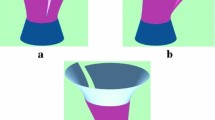Abstract
Blending surfaces form a smooth transition between two distinct, intersecting surfaces or smoothly join two or more disconnected surfaces and are normally procedural surfaces which are difficult to exchange and to interrogate in a reliable and efficient manner. In this paper, an approximation method for blending surfaces which are curvature continuous to the underlying surfaces with a non-uniform rational B-spline (NURBS) surface is presented. The use of NURBS is important since it facilitates the exchange of geometric information between various computer aided design and manufacturing systems. In the method, linkage curves on the underlying surfaces are approximated to within a specified tolerance and cross-link curves are created using the linkage curves, a directional curve and the parametric partial derivatives of the underlying surfaces. Cross-link curves are lofted to form the blending surface and an adaptive sampling procedure is used to test the blending surface against specified tolerances. Cross-link curves are added, where necessary, and the surface relofted until the continuity conditions are satisfied to within specified tolerances. Examples illustrate the applicability of the method.
Similar content being viewed by others
References
Smith, B.; Rinaudot, G.R.; Reed, K.A.; Wright, T. (1988) Initial Graphics Exchange Specification (IGES), Version 4.0, National Bureau of Standards, NBSIR 88-3813, Washington D.C.
Woodwark, J.R. (1987) Blends in geometric modelling, The Mathematics of Surfaces II (Martin, R.R., Editor), Clarendon Press, Oxford, 255–297
Filkins, P.C. (1991) Algorithms for blending surface generation, Engineer's thesis, Massachusetts Institute of Technology, Department of Ocean Engineering, Cambridge, Massachusetts
Pegna, J. (1987) Variable sweep geometric modeling, PhD Thesis, Stanford University, Stanford, Connecticut
Pegna, J.; Wilde, D.J. (1988) Spherical and circular blending of functional surfaces. Proceedings of the 7th International Conference on Offshore Mechanics and Arctic Engineering, Houston, Texas, February, Vol. 7, ASME, New York, 73–82
Sanglikar, M.A.; Koparkar, P.; Joshi, V.N. (1990) Modelling rolling ball blends for computer aided geometric design, Visual Computer, 7, August, 399–414
Koparkar, P. (1990) Designing parametric blends: surface model and geometric correspondence, Visual Computer, 7, 39–58
Hansmann, W. (1985) Interaktiver Entwurf und geometrische Beschreibung glatter Übergänge zwischen räumlich gekrümmten Flächenstrukturen, PhD Thesis, Fachbereich Informatik der Universität Hamburg
Hansmann, W. (1987) Interactive design and geometric description of smooth transitions between curved surfaces, Computers in Offshore and Arctic Engineering, 6th International Symposium on Offshore Mechanics and Arctic Engineering, Houston, Texas, ASME, New York, 19–26
Pegna, J. (1989) Interactive design of curvature continuous fairing surfaces, Proceeding of the 8th International Conference on Offshore Mechanics and Arctic Engineering, The Hague, The Netherlands, March, Vol. VI, ASME, New York, 191–198
Pegna, J.; Wolter, F.E. (1989) A simple practical criterion to guarantee second order smoothness of blend surfaces, Proceedings of the 15th Design Automation Conference, Montreal, Canada, September, Vol. I, ASME, New York, 93–105
Bloor, M.I.G.; Wilson, M.J. (1989) Generating blend surfaces using partial differential equations. Computer Aided Design, 21, 165–171
Bardis, L.; Patrikalakis, N.M. (1989) Blending rational B-spline surfaces, Eurographics '89, European Computer Graphics Conference and Exhibition, Hamburg, Germany, September 453–462
Patrikalakis, N.M.; Bardis, L. (1989) Offsets of curves on rational B-spline surfaces, Engineering with Computers, 5, 39–46
Tuohy, S.T. (1991) Sculptured shape creation, approximation, and interrogation, Engineer's thesis, Massachusetts Institute of Technology, Cambridge, Massachusetts
Tuohy, S.T.; Patrikalakis, N.M. (1991) Geometric representation of marine propulsors, Marine Computers '91: Proceedings of the Second Symposium on Computer Applications in the Marine Industry, Burlington, Massachusetts, September, SNAME, New England Section, Paper CC4
Tiller, W. (1983) Rational B-splines for curve and surface representation, IEEE Computer Graphics and Applications, 3, 6 (September), 61–69
De Boor, C. (1978) A Practical Guide to Splines, Springer, New York
Wolter, F.-E.; Tuohy, S.T. (1992) Approximation of high degree and procedural curves, Engineering with Computers, 8, 61–80
Bardis, L.; Patrikalakis, N.M. (1990) Surface approximation with rational B-splines, Engineering with Computers, 6, 4, 223–235
Tuohy, S.T.; Bardis, L. (1992) Low degree approximation of high degree B-spline surfaces, Engineering with Computers [in press]
Hottel, G.R.; Tuohy, S.T.; Alourdas, P.G.; Patriklakis, N.M. (1991) Praxiteles: a geometric modeling and interrogation system, Marine Computers '91: Proceedings of the Second Symposium on Computer Applications in the Marine Industry, Burlington, Massachusetts, September, SNAME, New England Section, Paper CC5
Pegna, J.; and Wolter, F.-E. (1990) Designing and mapping trimming curves on surfaces using orthogonal projection. Proceedings of the 16th ASME Design Automation Conference: Advances in Design Automation, Computer Aided and Computational Design (Ravani, B., Editor), Chicago, Illinois, September, Vol. I, ASME, New York, 235–245
Sabol, W.J. (1983) Analytic fillet development for marine propulsors, Technical Memorandum File No. 83-01, Applied Research Laboratory, Pennsylvania State University, January
Patrikalakis, N.M.; Bardis, L. (1992) Feature extraction from B-spline marine propeller representations, Journal of Ship Research, 36, 3 (September), 233–247
Numerical Algorithms Group (1989) NAG Forthan Library Manual, Mark 13 edition, Numerical Algorithms Group, Oxford
Author information
Authors and Affiliations
Rights and permissions
About this article
Cite this article
Filkins, P.C., Tuohy, S.T. & Patrikalakis, N.M. Computational methods for blending surface approximation. Engineering with Computers 9, 49–62 (1993). https://doi.org/10.1007/BF01198253
Issue Date:
DOI: https://doi.org/10.1007/BF01198253




